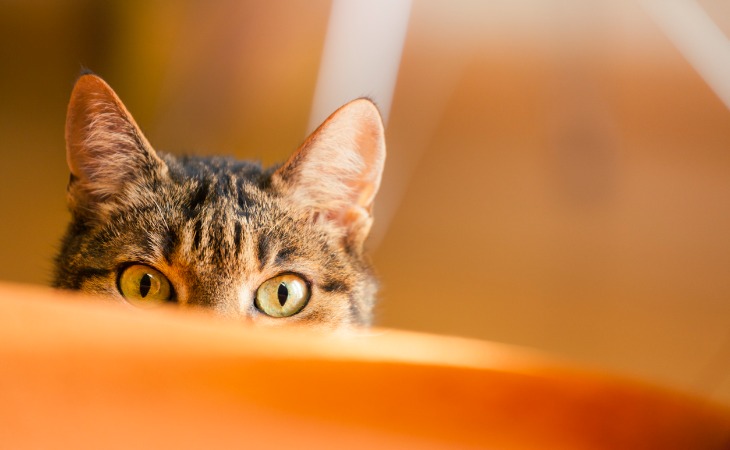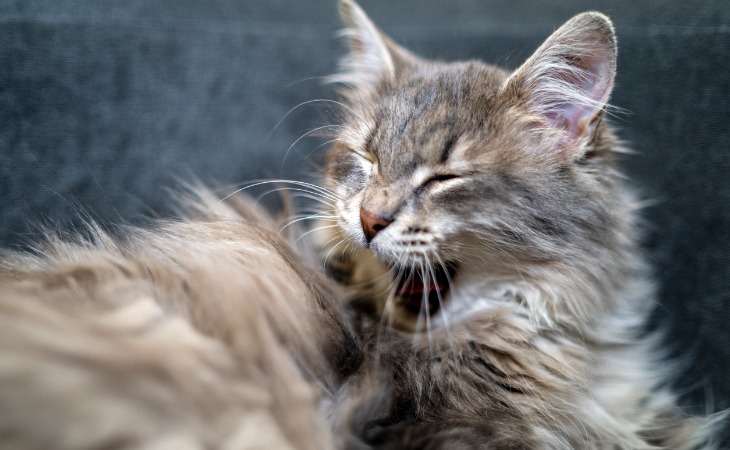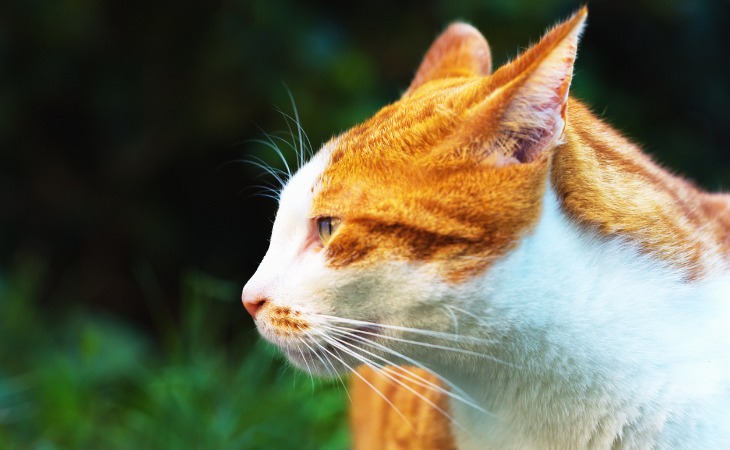Unfortunately, cats cannot communicate the way that we do. That’s why learning how to understand your cat’s body language is important! Their expressions are numerous and learning to decode them will allow you to better understand your cat’s emotions. In this article, we’ll go over a few ways cats use their body language to communicate.
Understanding what your cat’s body language means
If you want to be able to understand your cat, you have to observe their body language. First, we will show you how to understand your cat’s facial expressions. Then, we will teach you how to decipher their tail movements and their sounds.
Cats and their facial expressions
Cats have extremely expressive faces. Here are a few things to pay attention to.
- Their eyes are one of the first things that you should observe. For instance, their pupils help to communicate a few things. If they dilate really quickly or when it isn’t dark, it means that your four-legged friend’s attention is drawn to something or they are feeling excited. However, it could also mean that your cat is feeling surprised or scared. Their eyes also dilate when they are playing or hunting. When it comes to slowly blinking their eyes at you, this is the equivalent of a kiss. You can reciprocate this by blinking your eyes slowly back at them. They might respond by doing the same thing back to you!
- Secondly, their whiskers detect movements and are sort of like a radar, allowing them to feel certain things around them. For instance, they use their whiskers when hunting. They are really important to them. Additionally, whiskers can indicate how your cat is feeling. If they are pointing away from their face, your cat is probably feeling scared. If they are resting on the sides, your cat is most likely relaxed. When they are pointing all the way forward, this could mean that your cat is alert.
- Lastly, you can observe your cat’s ears to understand how they are feeling. Their ears have 32 muscles and move separately. When they are faced backwards, it can indicate that they are feeling frightened.
Now that you have an idea of what these facial expressions mean, we’ll now should you how to decipher the rest of their body language.

Their tail movements
Similar to their ears, their tails allow us to decode their emotions.
- When your cat’s tail is raised up proudly like a squirrel, this means “Look, it’s me!” or “Look how happy I am to be here!”.
- If your cat’s tail starts to quiver, it could mean that your cat is playing or wants to play.
- When your cat’s tail is puffed, it means that your cat is very angry. Your cat is trying to make themselves bigger to keep an enemy away.
Understanding the sounds your cat makes
Cats use a wide range of vocal sounds to express how they are feeling. By listening to and observing them, you will have a better understanding of what they want or need.
You might also like: Understanding the meaning behind different cat sounds
Meowing
Meowing is the most versatile means of communication for your four-legged friend. They use it for everything: to ask for food, to ask to go out, or to express pain. In general, they will stand in front of the object that interests them. This could be an empty bowl, a closed door, or even a treat that has slipped under a piece of furniture. It’s their way of calling you. That being said, cats only meow to communicate with you—not with other cats. One of the few times a cat will meow to get another cat’s attention is when they are in heat. Depending on the breed, cats can be more or less vocal. While some will give you the impression that you are having a real conversation with them, others will hardly meow at all.
Growling and hissing
Is your cat growling or hissing? In general, this means that they want to be left alone. They are not happy at all.
Purring
Most often, a cat purrs when it is calm and happy. In fact, their purring is even good for you. “Purr therapy” has become a recognized method of stress relief. It is believed that cats recognizes stress or pain in humans and adapt the frequency of their purring. However, purring can also mean that your cat is under a lot of stress or in pain. Once again, it is your cat’s body language as a whole that will help you to better understand how they are really feeling.

Body language: a few universal signs
Similar to human beings, certain gestures can be more or less universal.
Friendship
Your cat, if well cared for and loved, will be grateful to you all their life. All you have to do is respect their privacy, let them sleep, play with them, ensure they have a clean litter box and feed them. Most of the time, your cat will be in a peaceful position, walking around like proud lion. Additionally, they will lie on their backs, showing you their bellies.
When your cat is feeling good and friendly, they will come and rub against you or on the furniture to leave their scent. If they are feeling particularly happy and at peace, they will knead objects or your body. This reminds them of when they were still kittens with their mother’s belly. Some cats do this directly on you, while others prefer kneading a small blanket.
If your cat is feeling close to you, they will also love to play with you. For apartment cats, playing with them gives them the opportunity to exercise and practice their hunting skills.
When outdoor cats bring you a dead animal, it is because they want to prove to you that they are good hunters.
Anxiety and stress
Stress can be easily recognized through a cat’s body language. If your cat is alert, their tail will be low. Futhermore, if they are really worried, their ears will also be low. Sometimes you’ll see your little one moving very slowly, staying close to the ground, and trying to stay silent while walking. This is because they are being cautious. Lastly, if they are frightened, your cat’s fur might become puffed and bristly. They might also start to crab walk to get away from the situation.
Anger
A cat can show its anger in many ways. When cats are really upset, they can be particularly aggressive. If you treat your cat right, this should never happen to you. When a cat is wagging their tail with its eyes slightly furrowed, it usually means that it is feeling irritated.
If your cat is offended, they will usually sit with their back to you and will not answer you when you call. They might also sulk.
When cats are really angry, they’ll warn you by showing with their whole body that they are ready to pounce, with their ears and whiskers facing backwards. Sometimes, they might even have a paw raised. To reassure your cat, do not touch them. You should just leave you four-legged friend alone.
So? Do you speak cat?
Through experience and careful observation of your furry friend, you will learn to understand them. You may even be able to have a real conversation with your cat. Just be kind and understanding.
Cats can show many other emotions through their body language. It’s up to you to have fun discovering them!

